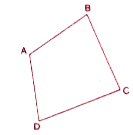In quadrilateral ABCD, side AB is parallel to side DC. If ∠A:∠D=1:2and∠C:∠B=4:5.
(i) Calculate each angle of the quadrilateral.
(ii) Assign a special name to quadrialateral ABCD.
The correct Answer is:(i)∠A=60∘,∠B=100∘,∠C=80∘and∠D=120∘ (ii) Trapezium
To solve the problem, we will follow these steps:
Step 1: Understand the relationships between the angles
We know that in quadrilateral ABCD, side AB is parallel to side DC. Therefore, angles A and D are co-interior angles, and angles B and C are also co-interior angles. This gives us the following equations:
- ∠A+∠D=180∘
- ∠B+∠C=180∘
Step 2: Set up the ratios for angles A and D
We are given that the ratio of angle A to angle D is 1:2. We can express this as:
- Let ∠A=x
- Then ∠D=2x
Step 3: Substitute into the equation for angles A and D
Using the equation from Step 1:
∠A+∠D=180∘
Substituting the expressions for angles A and D:
x+2x=180∘
This simplifies to:
3x=180∘
Step 4: Solve for angle A
Now, divide both sides by 3:
x=180∘3=60∘
Thus:
- ∠A=60∘
- ∠D=2x=2×60∘=120∘
Step 5: Set up the ratios for angles B and C
Next, we are given that the ratio of angle C to angle B is 4:5. We can express this as:
- Let ∠C=4y
- Then ∠B=5y
Step 6: Substitute into the equation for angles B and C
Using the equation from Step 1:
∠B+∠C=180∘
Substituting the expressions for angles B and C:
5y+4y=180∘
This simplifies to:
9y=180∘
Step 7: Solve for angle B
Now, divide both sides by 9:
y=180∘9=20∘
Thus:
- ∠B=5y=5×20∘=100∘
- ∠C=4y=4×20∘=80∘
Step 8: Summarize the angles
Now we have calculated all the angles:
- ∠A=60∘
- ∠B=100∘
- ∠C=80∘
- ∠D=120∘
Step 9: Identify the type of quadrilateral
Since AB is parallel to DC and the other sides are not parallel, quadrilateral ABCD is a trapezium.
Final Answer
(i) The angles of quadrilateral ABCD are:
- ∠A=60∘
- ∠B=100∘
- ∠C=80∘
- ∠D=120∘
(ii) Quadrilateral ABCD is a trapezium.
We know that in quadrilateral ABCD, side AB is parallel to side DC. Therefore, angles A and D are co-interior angles, and angles B and C are also co-interior angles. This gives us the following equations:
- ∠A+∠D=180∘
- ∠B+∠C=180∘
We are given that the ratio of angle A to angle D is 1:2. We can express this as:
- Let ∠A=x
- Then ∠D=2x
Using the equation from Step 1:
∠A+∠D=180∘
Substituting the expressions for angles A and D:
x+2x=180∘
This simplifies to:
3x=180∘
Now, divide both sides by 3:
x=180∘3=60∘
Thus:
- ∠A=60∘
- ∠D=2x=2×60∘=120∘
Next, we are given that the ratio of angle C to angle B is 4:5. We can express this as:
- Let ∠C=4y
- Then ∠B=5y
Using the equation from Step 1:
∠B+∠C=180∘
Substituting the expressions for angles B and C:
5y+4y=180∘
This simplifies to:
9y=180∘
Now, divide both sides by 9:
y=180∘9=20∘
Thus:
- ∠B=5y=5×20∘=100∘
- ∠C=4y=4×20∘=80∘
Now we have calculated all the angles:
- ∠A=60∘
- ∠B=100∘
- ∠C=80∘
- ∠D=120∘
Since AB is parallel to DC and the other sides are not parallel, quadrilateral ABCD is a trapezium.
(i) The angles of quadrilateral ABCD are:
- ∠A=60∘
- ∠B=100∘
- ∠C=80∘
- ∠D=120∘
Topper's Solved these Questions
Similar Questions
In a hexagon, ABCDEF, side AB is parallel to side FE and ∠B:∠C:∠D:∠E=6:4:2:3 Find ∠Band∠D.
View SolutionIn a pentagon ABCDE, AB is parallel to DC and ∠A:∠E:∠D=3:4:5. Find angle E.
View SolutionIn a cyclic quadrilateral ABCD ∠A:∠C=3:1and angle B : angle D = 1 : 5 find each angle of the quadrilateral
View SolutionIn a pentagon ABCDE, AB is parallel to DC and ∠A:∠E:∠D=3:4:5. Find angle E.
View SolutionIn quadrilateral ABCD ,side DC is largest show that AB + AD > DC - BC
View SolutionIn quadrilateral ABCD, AB is the shortest side and DC is the longest side. Prove that :
(i) ∠B>∠D
(ii) ∠A>∠C

View SolutionIn a pentagon ABCDE, AB is parallel to ED and angle B=140∘. Find the angles C and D, if ∠C:∠D=5:6
View SolutionABCD is a quadrilateral in which AB||DC and AD = BC. Prove that ∠A=∠Band∠C=∠D.
View SolutionGiven : In quadrilateral ABCD, ∠C=64∘,∠D=∠C−8∘,∠A=5(a+2)∘and∠B=2(2a+7)∘. Calculate ∠A.
View SolutionIn quadrilateral ABCD, AD = BC and BD = CA. Prove that :
(i) ∠ADB=∠BCA
(ii) ∠DAB=∠CBA
View Solution
